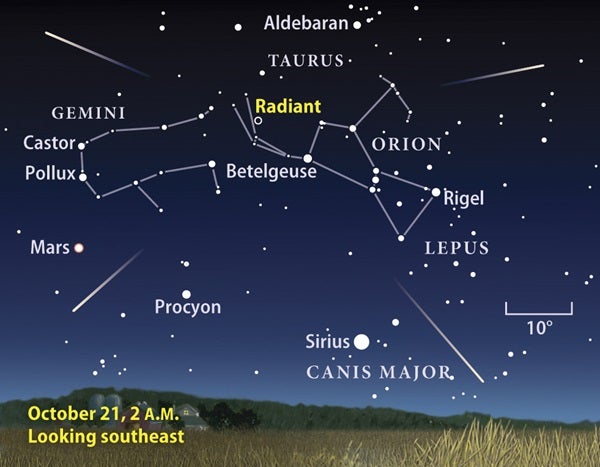One of the year’s better meteor showers makes its appearance in the coming week. The Orionid shower peaks the night of October 20/21, with the best views coming before dawn on the 21st. In a good year, observers can expect to see 20 to 30 “shooting stars” per hour — an average of one every 2 to 3 minutes — at the Orionids’ peak.
According to Astronomy magazine Senior Editor Michael E. Bakich, conditions could hardly be better this year. “New Moon arrives October 17/18, and by the 20th, it’s a slim crescent that sets before 8 p.m. local daylight time,” he says.
Watch the video: How to observe meteor showers
Listen to this week’s observing podcast: Orionid meteor shower, open cluster NGC 7789, and the Bubble Nebula
With no Moon to interfere, observers will be able to see all the shower has to offer. The Orionids produced more meteors than normal in 2006 and 2007, and some astronomers think we may be in for another above-average show this year.
These meteors began life as tiny specks of dust ejected by Comet 1P/Halley during its innumerable trips around the Sun. Over the eons, these particles spread out along the comet’s orbit. Every October, we run into this stream of dust.
The particles hit Earth’s atmosphere at 147,000 mph (238,000 km/h), vaporizing from friction with the air and leaving behind the streaks of light we call meteors. The meteors appear to emanate from the northeastern part of the constellation Orion the Hunter (hence their name), near its border with Gemini.
The best views will come in the hours before dawn starts to paint the sky, between about 2 a.m. and 5 a.m. The shower’s radiant then lies higher in the sky, which means fewer meteors will disappear below the horizon.
Just as importantly, observers lie on Earth’s leading hemisphere in the hours after midnight. “Think of what happens when you drive through rain or snow — more precipitation pelts the front windshield than the rear,” says Bakich. In the same way, Earth runs head on into the dust stream after midnight and sweeps up more of the tiny dust particles.
If the weather looks iffy the morning of October 21, try viewing the morning before or after. The Orionid shower often produces a nearly steady stream of meteors for several consecutive nights.











